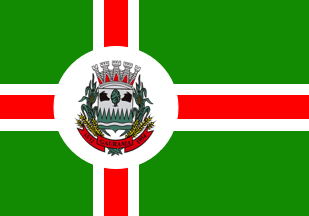 image by Ivan Sache, 18 July 2020
image by Ivan Sache, 18 July 2020 
Last modified: 2020-07-25 by ian macdonald
Keywords: rio grande do sul | gaurama |
Links: FOTW homepage |
search |
disclaimer and copyright |
write us |
mirrors
 image by Ivan Sache, 18 July 2020
image by Ivan Sache, 18 July 2020
The municipality of Gaurama (5,940 inhabitants in 2014; 20,427 ha) is located
400 km north of Porto Alegre.
Gaurama emerged in 1907, as Barro colony,
during the building of the São Paulo-Rio Grande railway by the Belgian Compagnie
Auxiliaire des Chemins de Fer. The Land Commission initiated in 1910 urban
planning of the new settlement, while most plots located around the railway
station had already been built. Accordingly, and as opposed to several other
municipalities, the railway station was the center of the town, which developed
along the railway.
http://www.gaurama.rs.gov.br/
Municipal website
The old railway station, disbanded in 1997, was registered as municipal
historical heritage by Municipal Law No. 2,164 promulgated in 1999. The Irmã
Celina Schardong Museum, established by Municipal Law No. 1,417 promulgated in
1987, was transferred to the station in 2006, and inscribed on the National
Register of Museum in 2013.
https://comunidadeviadutos.com.br/site/noticia/museu-municipal-irma-celina-schardong-e-reaberto-em-gaurama/1751
Rádio Comunidade FM Viadutos, 19 June 2016
Ivan Sache, 18 July 2020
The flag and arms of Gaurama are prescribed by Municipal Law
No. 857 promulgated on 23 August 1976.
Article 6.
The municipal flag
of Gaurama, designed by the heraldist and vexillologist Arcinoé Antonio Peixoto
de Faria, shall be quartered by a cross, with green quarters formed by white
stripes of two units in width superimposed with red stripes of one unit,
arranged horizontally and vertically and crossing at a distance of six units
from the hoist, where their are superimposed by a white circle of eight units in
circumference charged with the municipal coat of arms.
§1. In compliance
with the Portuguese tradition, and its inherited canons and rules, municipal
flags have to be divided in eight or six horizontal stripes, quartered or
divided in three parts, featuring the same colors as the field of the coat of
arms and in the center or at hoist a geometrical figure inscribing the municipal
coat of arms.
§2. The municipal flag of Gaurama obeys this general rule,
being quartered by a cross, symbolizing the people's Christian spirit. The coat
of arms applied on the flag represents the municipal government while the white
circle represents the town as the municipal seat; the circle is the heraldic
symbol of eternity, as a geometric figure without either a beginning or a end.
White is a symbol of peace, friendship, work, property, purity and religiosity.
The white stripes charged with red stripes represent the spread of municipal
power all over the territory. Red is a symbol of patriotic love, dedication,
audacity, intrepidity, courage and valiance. The green quarters represent the
rural estates scattered over the municipal territory. Green is a symbol of
honor, civility, courtesy, glee, and abundance; green is also a symbol of hope,
as greening fields in spring promising profuse harvests.
Article 7.
In
compliance with heraldic rules, the municipal flag shall have the official
dimensions adopted for the national flag, 14 units in width on 20 units in
length.
Article 19.
The coat of arms of Gaurama, designed by the
heraldist Arcinoé Antonio Peixoto de Faria,is described as follows:
A Samnite
shield surmounted by an eight-towered mural crown argent ports gules, argent a
mate shrub vert surrounded by two pigs affronty sable in base a serrated
mountain vert superimposed to a fess wavy argent. The shield supported dexter
and sinister by maize and wheat plants proper crossed in base and superimposed
by a scroll gules containing in letters argent the toponym "GAURAMA" and the
date "15-12-1954".
The coat of arms has the following symbolic
interpretation:
a) The Samnite shield, used to represent the arms of Gaurama,
was the first style of shield introduced to Portugal under French influence,
inherited by the Brazilian heraldry to evoke the colonizing race and main
builder of the nation;
b) The mural crown surmounting the shield is the
universal symbol of coat of arms of domains; argent (silver) with eight towers,
five visible in perspective, it classifies the town as of second rank or
district seat. [...]
c) Argent (silver) is a symbol of peace, friendship,
work, prosperity, purity and religious feeling.
d) In the center a mate shrub
vert (green), recalling the region's native product exported far from the
municipality, therefore a main source of income for the municipality.
e)
Surrounding the mate, pigs sable (black) representing the other source of income
for the municipality, pig-breeding, which has a model farm installed by
Frigorífico Ipiranga, providing noble races to the pig ranchers.
f) Sable
(black) is a symbol of austerity, prudence, wisdom, moderation, and firmness.
g) In base, the shield's lower part, a serrated mountain vert (green)
representing the mountains of Serra Geral where the municipality is located, and
a fess wavy argent (white) representing Rio de Peixe, one of the most important
rivers watering the municipality.
h) Vert (green) is a symbol of honor,
civility, courtesy, glee and abundance; green also represents hope, as greening
fields in spring promising profuse harvests.
i) The outer ornaments, wheat
and maize, represent the main products of the generous and fertile soil.
j)
On a scroll gules (red), a symbol of dedication, patriotic love, audacity,
intrepidity, courage, valiance in letters argent (silver) the identifying
toponym "GAURAMA" surrounded by the date of political emancipation,
"15-12-1954".
https://alvorada.cespro.com.br/visualizarDiploma.php?cdMunicipio=7533&cdDiploma=19760857
CESPRO portal
Photos
http://www.gaurama.rs.gov.br/site/noticia/?pagina=24¬icia=168/vice-prefeito-assume-o-executivo-municipal-
https://comunidadeviadutos.com.br/site/noticia/gaurama-da-inicio-ao-seu-primeiro-festival-literario-e-artistico/4940
https://comunidadeviadutos.com.br/site/noticia/museu-municipal-irma-celina-schardong-e-reaberto-em-gaurama/1751
Ivan Sache, 18 July 2020